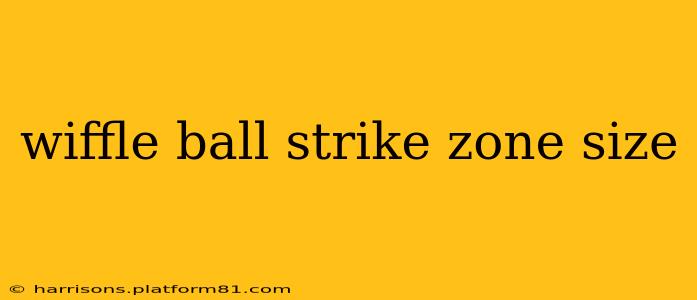Wiffle ball, a beloved backyard game, often lacks the strict rules and precise measurements of its major league counterpart. While there isn't an officially defined strike zone size like in professional baseball, understanding the implied dimensions helps ensure fair play and enjoyable games. This guide delves into the practical considerations of the wiffle ball strike zone, answering common questions and providing tips for consistent gameplay.
What is the official Wiffle ball strike zone size?
There isn't an "official" strike zone size for Wiffle ball. The game's informal nature allows for flexibility and adaptation based on the players' ages, skill levels, and the playing environment. However, a commonly accepted guideline focuses on the batter's height and the pitcher's ability to consistently throw strikes within a reasonable area.
How big is the Wiffle ball strike zone?
The size of the wiffle ball strike zone is largely determined by common sense and the agreement of the players involved. Generally, it's considered a rectangular area roughly encompassing the batter's torso, from armpit to knees, and extending across their width. Younger players may have a slightly larger strike zone adjusted to their smaller size, while older players might have a slightly smaller one.
What is considered a strike in Wiffle ball?
A strike in wiffle ball is a pitch that, in the judgment of the umpire (often one of the players), passes through the agreed-upon strike zone. Factors like the ball's trajectory, the batter's swing, and the general flow of the game all contribute to the umpire's call. Unlike professional baseball, there isn't a precise measurement or technological aid defining the strike zone.
How do you determine the strike zone in Wiffle ball?
The determination of the strike zone in Wiffle ball is a collaborative effort. Before the game begins, or even during the game as needed, players should informally discuss and agree upon a reasonable strike zone that is fair to both the pitcher and the batter. This ensures everyone understands the boundaries and promotes a fair and enjoyable experience. The focus should be on fair play rather than strict adherence to rigid measurements.
Does the Wiffle ball size affect the strike zone?
While the size of the wiffle ball itself doesn't directly determine the strike zone, it influences the pitcher's accuracy and the batter's ability to hit. The larger holes in the wiffle ball make it more susceptible to unpredictable movement, which can impact where the pitch crosses the plate. Thus, the implied strike zone may be adjusted subtly based on the observed behavior of the particular wiffle ball in use.
What if the players disagree on a strike call?
Disagreements on strike calls are common in casual Wiffle ball games. The best approach is to maintain a spirit of sportsmanship and compromise. If a disagreement escalates, players might choose to replay the pitch, call a timeout to clarify the strike zone, or agree on a different umpire for subsequent calls.
In conclusion, the wiffle ball strike zone is a fluid concept dictated by common sense, mutual agreement, and fairness. While there's no official size, understanding the general principles of height and width, relative to the batter, is key to enjoying the game. Remember, the focus should be on fun and fair play – not rigid adherence to imaginary lines!
